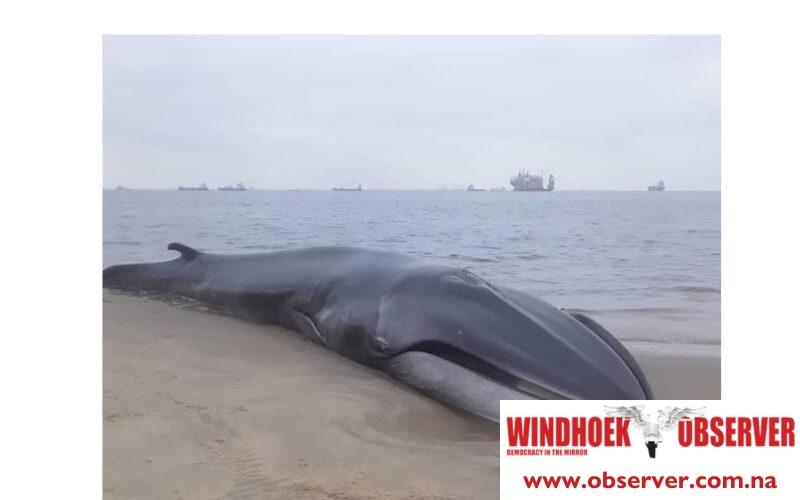Niël Terblanché
A sad incident unfolded over the weekend when a pelagic fin whale, a species rarely seen near shore, washed up on the Pelican Point peninsula near Walvis Bay.
Despite valiant efforts by members of the public to return the whale to the Atlantic Ocean, the animal, appearing emaciated, could not be saved.
Marine conservation experts believe pollution, specifically the ingestion of plastic, may have contributed to the whale’s condition and eventual death.
Naude Dreyer, from Ocean Conservation Namibia, stated that it is suspected that the whale’s inability to feed for an extended period likely led to its frail state.
Dreyer noted that the presence of floating plastic bags in the ocean can block the throats of these animals, causing them to starve slowly.
“When these animals are near death, they tend to come closer to shore and ultimately beach themselves,” he explained.
This particular fin whale was in poor health, with no visible signs of injury from a possible ship strike. Colliding with ships often harms marine animals.
Experts from South Africa, who reviewed images of the beached whale confirmed that it had likely been unable to feed for some time, and its emaciated state was consistent with long-term starvation.
Fin whales are known to be pelagic creatures, typically inhabiting the deep waters of the ocean, making their appearance near shore an uncommon and troubling sign.
Dreyer pointed out that while ship strikes are a common cause of injury for whales, no such marks were found on this animal, reinforcing the theory that pollution, not collision, was the probable cause.
Marine biologists have also raised concerns that public attempts to push the whale back into the ocean may have exacerbated its distress.
Experts warned that such efforts, while well-meaning, often increase stress and harm to the already weakened animal.
“The best option in such cases is to let nature take its course,” Dreyer said.
According to Wikipedia, the fin whale, the second-largest sea mammal after the blue whale, is often called the “greyhound of the sea” due to its slender, streamlined body and ability to reach speeds of up to 50 kilometres per hour.
These baleen whales filter-feed on krill, small fish, and squid in the nutrient-rich waters of the Southern Atlantic.
They use their pleated throats to expand and engulf large quantities of water and prey, filtering the food through their baleen plates.
Once abundant, the fin whale population suffered dramatic losses due to commercial whaling during the 20th century.
By the 1970s, their numbers in the Southern Hemisphere had been reduced by more than 70%, with only around 38 000 individual whales remaining from a population estimated to be over 725 000 before whale hunting on a grand scale commenced.
Despite a moratorium on whaling, the species has been slow to recover and remains classified as vulnerable by the International Union for Conservation of Nature (IUCN).
Estimates of the global fin whale population today range between 50 000 to 90 000, with a concentration in the North Atlantic.
According to Wikipedia, their recovery is sluggish in the Southern Hemisphere due to the lasting impacts of overhunting, environmental changes, and modern threats such as pollution and ship strikes.
Although protected from whaling, marine mammals always face danger from ocean pollution, particularly plastics, which can obstruct their feeding mechanisms and lead to starvation, as seen in the case of the whale at Pelican Point.
According to Dreyer, the dying whale on the beach near Walvis Bay is a stark reminder of the fragile balance between healthy marine life and human activity and pollution.




